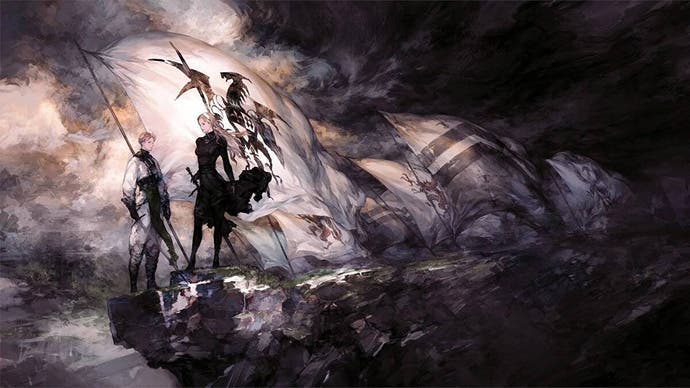Tactics Ogre: Reborn review - a genre-forming TRPG gets another terrific revival
Vyce squad.
My favourite remakes tend to be a little disrespectful towards the games they're remaking, engaging in mildly subversive dialogue with the old creative choices, rather than just trying to 'improve' them in accordance with the expectations of the day. As such, my pick of Tactics Ogre: Reborn's new features is a rebellious flourish - the buff card system, a cousin of the returning Tarot cards from the original 1995 launch on SNES.
It works like this: power-up cards for critical chance, physical or magic stats and the odds of triggering each unit's passive abilities spawn semi-randomly across each isometric map, as you take turns to move your troops. Each of your units can gather up to four cards, keeping the effects till the battle is over (Tarot cards, dropped infrequently by dying enemies, confer permanent boosts). It's tempting to ignore these buffs when they materialise off the beaten path, appearing on squares that don't fit into your strategy, but they can be decisive in letting you temporarily override level gaps or class disadvantages.
Take ninjas. They've got some sexy kit - blowpipes with which to mute or petrify troublesome Wizards, the ability to strike twice with a weapon in each hand - but they also struggle to make a dent on tougher Warriors and Knights. So why not have your Ninja tour the perimeter while said Warriors and Knights duke it out, harvesting attack buffs before pouncing on the enemy rearguard. Better yet, try it with a beefier flying unit such as a Gryphon: they can swoop right over the frontline to chase down cards before your enemies bag them.
The appeal of the buff card system is that it doesn't merely expand, but tugs provocatively against the age-old tactical RPG rhythms of striking from the side or rear, pairing off combatants by class or element, and monitoring the character turn order to anticipate and thwart the AI. The buff cards not only give you smaller, pop-up objectives to weave into your manoeuvres, but inspire you to take jarring risks. You might charge a fragile Cleric into the moshpit to steal a buff from the other side's Swordmaster, or have your Berserker pick up an auto-ability card rather than punching out an exposed Archer - with any luck, the greater frequency of Berserk rampages later will be worth the greater frequency of arrows to the face.
Breakaway mechanics like this are the cherries atop a chunky confection of new and revised RPG systems, presented in higher definition with new orchestral audio and voice-acting. There have certainly been stranger variations on the concept of RPG chess, but Tactics Ogre remains one of the finest for all its years, and Reborn - which mixes ideas from the 1995 game and its comprehensive PSP adaptation - puts a distinct stamp on things.
The quirky buff card system aside, it's defined by reduced fuss and greater flexibility, or at least, a different style of flexibility versus the PSP game in particular. Rather than levelling up whole classes, you level up individual units, which makes even generic characters feel less like cannon fodder - though you're free to treat them as such, hiring fresh faces at towns as you truck about the parchment overworld.
Active and passive abilities unlock automatically as your troops gain levels, rather than being bought separately with skill points, and grow more potent simply through use. There are fewer restrictions on equipment within class parameters - a Warrior can wield every kind of sword straight away - plus new charms that let you change unit elemental affinities, dole out bonus XP and raise their stats between encounters. This proves handy when you've been neglecting a party member, as there's no XP earning outside combat.
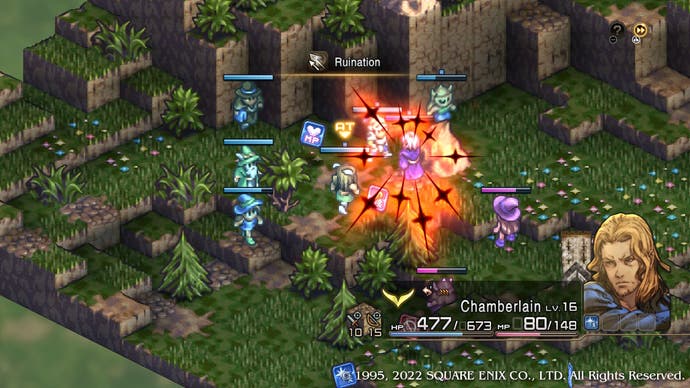
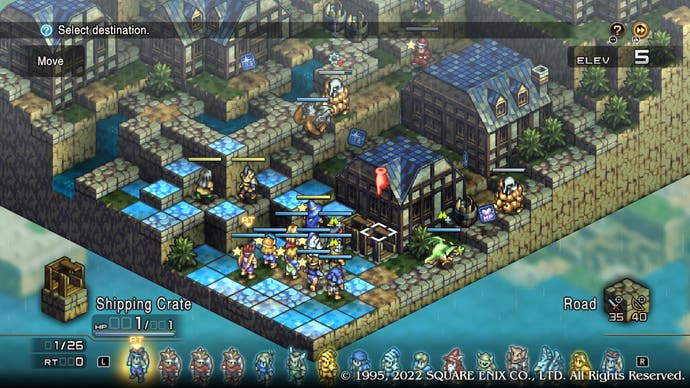
It's a relatively freeform RPG, but there are certain constraints that might annoy fans of the PSP game. Each character is limited to four individual spells and four active or passive abilities, rather than, say, equipping Air Magic to access all the associated sorcery. This tighter focus chimes with the new option to preview battle maps - the idea is to keep re-specialising characters in a more granular way, based on your reconnaissance - but I suspect the associated extra time in menus will prove divisive, all the same. There are also party level caps tethered to plot developments, with any XP beyond the cap converted into charms. While these feel a bit contrived, they also stop you grinding your way to supremacy in training battles, which can be triggered manually; random battles have been taken out entirely.
The old games were infamous for their difficulty spikes, and even with this more controlled level progression, I've had some bruising moments. At one juncture, I had to belatedly respec my protagonist as a Knight to survive a duel with an enemy capable of acting twice per turn. It's just as well I had charms to spare. If you wanted to be obnoxious, you could argue that these occasional car-crash reversals are appropriate to the story - a torrid political epic heavily inspired by real-life wars, betrayals and acts of genocide.
It's the tale of three young revolutionaries, Denam, Vyce and Catiua, struggling to uphold their ideals in a world of simmering bigotry and backstabbing nobles, where blood relatives always seem to end up on opposing sides. The story is memorable partly for its baleful insistence that there are no righteous actions in wartime, and partly for the ornate English localisation, with such killer lines as "the ground be your graves, whey-faced Walisters!" Reborn's English voice actors do a good job of making it all not sound totally ridiculous, though I preferred the Japanese cast simply for the occasional, interesting discrepancy between audio and script: the English localisation of Catiua can be a lot more assertive, for example.
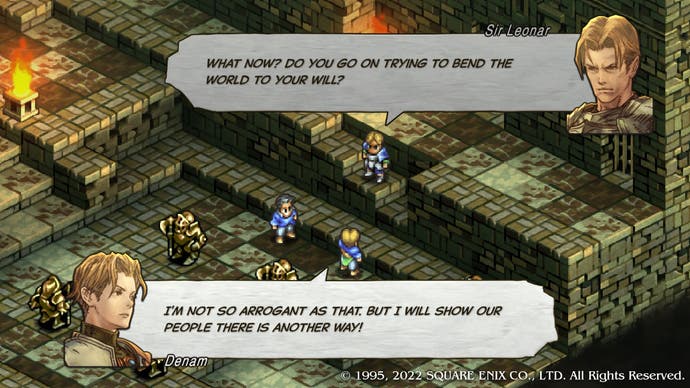
It's a bloody ordeal throughout, but at the level of combat itself, not quite an exercise in crushing despair on par with old-school XCOM. Units can be revived once KO'd providing you use a Blessing Stone or win the battle within three turns, save for certain story characters who either perish instantly (if you skip the dying soliloquy) or teleport away. Rather than a loss, this allows you to treat resurrecting units as a macabre bonus win condition. There's also the returning Chariot system from the PSP game, which lets you roll back a few turns in certain battles to avert disaster.
That replay-friendliness applies to the campaign as a whole: key decisions branch the plot, but you can rewind to those fateful lines of dialogue post-completion to reach the other endings without starting over. Stir in optional, multi-stage dungeons - often the safest way to recruit Dragons and the like who may otherwise be slaughtered by AI-controlled story characters - and it's not a game you'll clean out before Christmas.
Reborn has adjustments to spare. I particularly appreciated being able to toggle floating health bars, see elemental relationships when targeting units, and set battle animations to fast-forward. The UI has been generously and persuasively redesigned, though it might still give you eye-strain. On the one hand, there are new icons for spells to help you keep track of them. On the other hand, I grew to dislike having menus popping up over the selected character on crowded maps, rather than tabbing down the left of the screen.
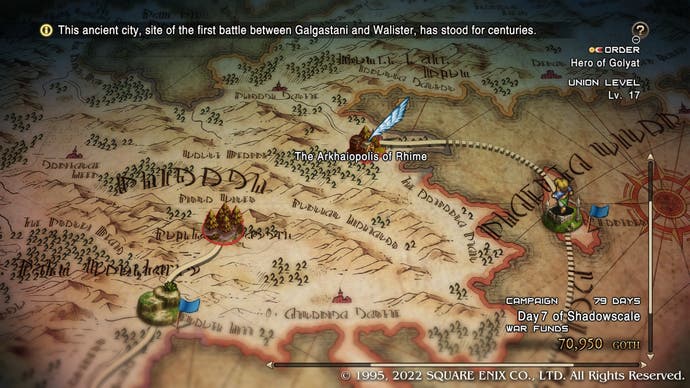

I'm also unsure about the spruced-up AI. Foes make a point of targeting squishier classes or under-levelled characters, while healing and buffing their friends but conversely battles have a familiar, false tempo with powerful leaders hanging back to begin with, letting you batter their minions to pieces. It feels like the challenge arises far more from the terrain and initial unit distribution than the AI's antics. This isn't really a criticism, however - as with chess puzzles, it's satisfying to watch the designers shape the odds simply by imposing layouts where certain classes are stronger or weaker. For example, a sewer map with stepping stones, forcing your Berserkers to form orderly queues, or fields with deep pits your Clerics are unable to escape.
Much like a Ninja combing the map periphery for buff cards, I've taken the long way round to properly enjoying Tactics Ogre. I've spent far more time with the many games it has inspired, including oddballs such as Tenderfoot Tactics and the inimitable Disgaea series, which lets you stack units like dishes and wage war inside your own equipment.
You might think I'd find this game dull, after tackling the above. In practice, I've found it to be a work of incredible richness and surprise, even discounting Reborn's many tweaks and additions: you can see hints of Disgaea's chaotic style, for instance, in the moderately crazy methods necessary to keep enemies alive so that you can recruit or tame them. The more I dig in - and there's much more to say than I have time for here - the more I understand what a long shadow Tactics Ogre has cast. Even if you don't play this version, it's a game you should definitely play.
